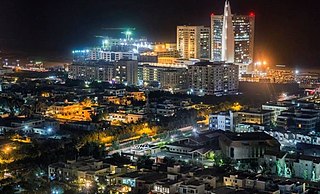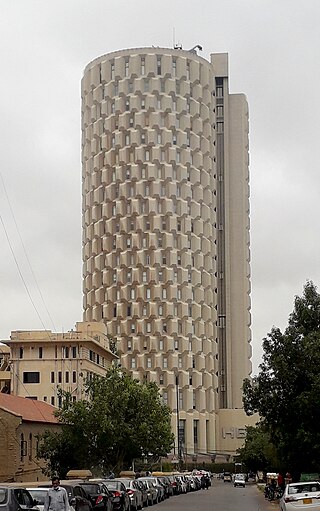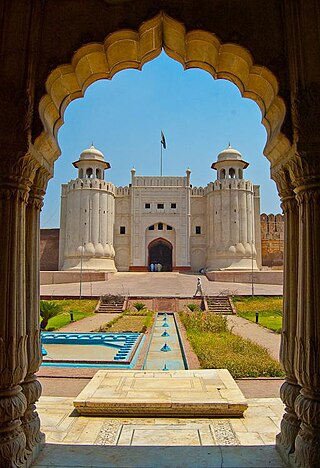
The economy of Pakistan is categorized as a developing economy. It ranks as the 24th-largest based on GDP using purchasing power parity (PPP) and the 46th largest in terms of nominal GDP. With a population of 241.5 million people as of 2023, Pakistan's position at per capita income ranks 161st by GDP (nominal) and 138th by GDP (PPP) according to the International Monetary Fund (IMF).

The districts of Pakistan are the third-level administrative divisions of Pakistan, below provinces and divisions, but forming the first-tier of local government. In total, there are 166 districts in Pakistan, including the Capital Territory, and the districts of Azad Kashmir and Gilgit-Baltistan. These districts are further divided into tehsils and union councils.

The State Bank of Pakistan (SBP) is the central bank of Pakistan. Its Constitution, as originally laid down in the State Bank of Pakistan Order 1948, remained basically unchanged until 1 January 1974, when the bank was nationalised and the scope of its functions was considerably enlarged. The State Bank of Pakistan Act 1956, with subsequent amendments, forms the basis of its operations today. The headquarters are located in the financial capital of the country in Karachi. The bank has a fully owned subsidiary with the name SBP Banking Services Corporation (SBP-BSC), the operational arm of the Central Bank with Branch Office in 16 cities across Pakistan, including the capital Islamabad and the four provincial capitals Lahore, Karachi, Peshawar, Quetta. The State Bank of Pakistan has other fully owned subsidiaries as well: National Institute of Banking and Finance, the training arm of the bank providing training to Commercial Banks, the Deposit Protection Corporation, and ownership of the Pakistan Security Printing Corporation.

The Bank of Korea is the central bank of South Korea and issuer of South Korean won. It was established on 12 June 1950 in Seoul, South Korea.

HabibMetro is a Pakistani commercial bank headquartered in Karachi. It is a subsidiary of Swiss bank Habib Bank AG Zurich.

Karachi is the financial and industrial capital of Pakistan. As of 2019, Karachi has an estimated GDP (PPP) of $164 billion. The city accounts about half of the total collections of the Federal Board of Revenue, out of which, approximately half are customs duty and sales tax on imports. Karachi produces about 30 percent of value added in large-scale manufacturing, 25% of the GDP, the World Bank identified Karachi as the most business-friendly city in Pakistan. In 2010, research by the global human resources company Mercer found Karachi to be the most inexpensive city in the world.

The official religion of Pakistan is Islam, as enshrined by Article 2 of the Constitution, and is practised by an overwhelming majority of 96.35% of the country's population. The remaining 3.65% practice Hinduism, Christianity, Ahmadiyya, Sikhism, Zoroastrianism and other religions.

Habib Bank Limited is a Pakistani commercial bank based at Habib Bank Plaza, Karachi. It is a subsidiary of Swiss-based organisation Aga Khan Fund for Economic Development.

The Hub Power Company Limited, colloquially known as Hubco, is a Pakistani power company based in Karachi, Sindh. It was the first independent power producer (IPP) established in Pakistan, and before the termination of its energy agreement in October 2024, it was the largest IPP in the country.

Jahangir Siddiqui & Co. is a Pakistani financial services company, founded in 1971 by Jahangir Siddiqui, and is based in Karachi, Pakistan. The company controls and operates financial services companies in Pakistan.

Tourism in Pakistan is a growing industry. In 2010, Lonely Planet termed Pakistan "tourism's 'next big thing'". The country is geographically and ethnically diverse, and has a number of historical and cultural heritage sites. Condé Nast Traveller ranked Pakistan The Best Holiday Destination for 2020 and also declared it the third-highest potential adventure destination in the world for 2020. As security in the country improves, tourism increases; in two years, it has increased by more than 300%.
China's banking sector had CN¥417 trillion in assets at the end of 2023. The "Big Four" state-owned commercial banks are the Bank of China, the China Construction Bank, the Industrial and Commercial Bank of China, and the Agricultural Bank of China, all of which are among the largest banks in the world as of 2018. Other notable big and also the largest banks in the world are China Merchants Bank and Ping An Bank.

Bangladesh is a developing country with an impoverished banking system, particularly in terms of the services and customer care provided by the government run banks. In recent times, private banks are trying to imitate the banking structure of the more developed countries, but this attempt is often foiled by inexpert or politically motivated government policies executed by the central bank of Bangladesh, Bangladesh Bank. The outcome is a banking system fostering corruption and illegal monetary activities/laundering etc. by the politically powerful and criminals, while at the same time making the attainment of services or the performance of international transactions difficult for the ordinary citizens, students studying abroad or through distance learning, general customers etc.
Before Uganda's independence in 1962, the main banks in Uganda were Barclays ; Grindlays, Standard Bank and the Bank of Baroda from India. The currency was issued by the East African Currency Board, a London-based body. In 1966, the Bank of Uganda (BoU), which controlled the issue of currency and managed foreign exchange reserves, became the central bank and national banking regulator. The government-owned Uganda Commercial Bank and the Uganda Development Bank were launched in the 1960s. The Uganda Development Bank is a state-owned development finance institution, which channeled loans from international sources into Ugandan enterprises and administered most of the development loans made to Uganda.
Priority sector lending is lending to those sectors of the economy which may not otherwise receive timely and adequate credit. This role is assigned by the Reserve Bank of India to the banks for providing a specified portion of the bank lending to few specific sectors like agriculture and allied activities, micro- and small enterprises, education, housing for the poor, and other low-income groups and weaker sections. This is essentially meant for an all-round development of the economy as opposed to focusing only on the financial sector.
The Lalpir Power Complex, is a power plant complex located in Mehmood Kot, District Muzaffargarh, Punjab, Pakistan. It was active until October 2024, when Lalpir prematurely terminated its energy purchase agreement with the government of Pakistan amid concerns about coercion and threats of corruption cases against IPP owners if they sought international arbitration.

China–Pakistan Economic Corridor is a 3,000 km Chinese infrastructure network project currently under construction in Pakistan. This sea-and-land-based corridor aims to secure and shorten the route for China’s energy imports from the Middle East, avoiding the existing path through the Straits of Malacca between Malaysia and Indonesia, which could be blockaded in case of war, thereby threatening China’s energy-dependent economy. Developing a deep-water port at Gwadar in the Arabian Sea and establishing a robust road and rail network from this port to the Xinjiang region in western China would serve as a shortcut, enhancing trade between Europe and China. In Pakistan, the project aims to address electricity shortages, develop infrastructure, and modernize transportation networks, while also transitioning the economy from an agriculture-based structure to an industrial one.

The M-6 Motorway, or the Sukkur–Hyderabad Motorway, is an under-construction motorway project in Pakistan. It will connect Sukkur to Hyderabad. The 306 km long M-6 motorway is the only missing vital link of North to South connectivity, i.e. from Karachi to Peshawar. The motorway will cost approximately $1.7 billion to build. The M-6 will be a six-lane motorway with a design speed of 120 km/hour, 89 bridges, 15 interchanges and 243 underpasses.

The 2017 Census of Pakistan was a detailed enumeration of the Pakistani population which began on 15 March 2017 and ended on 25 May 2017. It was the first census taken in the country in the 21st century, nineteen years after the previous one in 1998, and it was carried out by the Pakistan Bureau of Statistics.

The COVID-19 pandemic in Pakistan is part of the pandemic of coronavirus disease 2019 caused by severe acute respiratory syndrome coronavirus 2. The virus was confirmed to have reached Pakistan on 26 February 2020, when two cases were recorded. On 18 March 2020, cases had been registered in all four provinces, the two autonomous territories, and Islamabad Capital Territory, and by 17 June, each district in Pakistan had recorded at least one confirmed case of COVID-19.
















